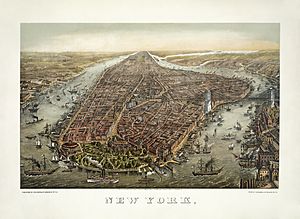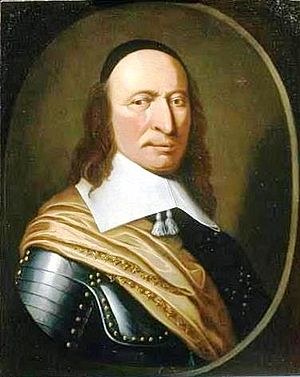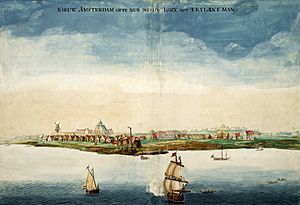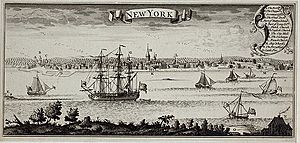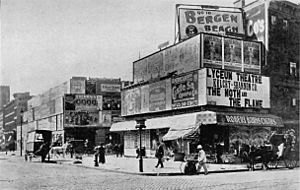History of New York City facts for kids
| City of New York Population by year |
|
|---|---|
| 1656 | 1,000 |
| 1690 | 6,000 |
| 1790 | 33,131 |
| 1800 | 60,515 |
| 1810 | 96,373 |
| 1820 | 123,706 |
| 1830 | 202,589 |
| 1840 | 312,710 |
| 1850 | 515,547 |
| 1860 | 813,669 |
| 1870 | 942,292 |
| 1880 | 1,206,299 |
| 1890 | 1,515,301 |
| 1900 | 3,437,202 |
| 1910 | 4,766,883 |
| 1920 | 5,620,048 |
| 1930 | 6,930,446 |
| 1940 | 7,454,995 |
| 1950 | 7,891,957 |
| 1960 | 7,781,984 |
| 1970 | 7,894,862 |
| 1980 | 7,071,639 |
| 1990 | 7,322,564 |
| 2000 | 8,008,278 |
| 2010 | 8,175,133 |
| Including the "outer boroughs" before the 1898 consolidation |
|
| 1790 | 49,000 |
| 1800 | 79,200 |
| 1830 | 242,300 |
| 1850 | 696,100 |
| 1880 | 1,912,000 |
The history of New York City started with the first European explorer, an Italian named Giovanni da Verrazzano, in 1524. People from Europe began to settle there when the Dutch arrived in 1608.
During the American Revolution, a group called the "Sons of Liberty" fought against British rule in New York City. Representatives from the Thirteen Colonies met in the city in 1765 for the Stamp Act Congress. They wanted to resist the British King's rules. New York City was a very important seaport, so the British wanted to take control of it in 1776. General George Washington lost several battles, but he managed to escape most of them. The Battle of Harlem Heights was his first victory. The British Army then took over New York and used it as their main base until 1783. Many people who supported the British, called Loyalists, moved there for safety.
New York City was the first capital of the United States from 1785 to 1789 under the Articles of Confederation. It was also the capital briefly from 1789 to 1790 under the new Constitution of the United States. During this time, George Washington became the first President of the United States in the city. The United States Bill of Rights was written there, and the first Supreme Court of the United States met there. The Erie Canal opened in 1825, connecting New York City to upstate New York and the Great Lakes. This made the city the most important port on the Atlantic Ocean. Later, in the 1840s and 1850s, new train lines also helped the city grow even more.
In the mid-1800s, many new immigrants came from Europe. They changed the city a lot and worked in its growing industries. Modern New York City really began when the five boroughs joined together in 1898. The city also saw a big economic and building boom after the Great Depression and World War II. New York has always been a main entry point for many immigrants. Its culture and economy have made it one of the most important cities in the United States and the world. In the 1700s, the economy relied on farming, making local goods, fur trading, and shipping. New York was known as a "breadbasket colony" because it grew a lot of wheat. It also exported iron ore and metal goods like tools and kitchen items.
Contents
Early Settlements: Native Americans and Europeans
The land that is now New York City was first home to the Lenape people. These Native Americans spoke a language called Unami. Early European settlers gave names to different Lenape groups based on where they lived. For example, the "Raritan" lived in Staten Island and New Jersey. The "Canarsee" lived in Brooklyn, and the "Hackensack" lived in New Jersey, across the Hudson River from Lower Manhattan. People on eastern Long Island were more like the Mohegan-Pequot tribes of New England.
All these groups used the many waterways in the New York City area for fishing, hunting, trading, and sometimes fighting. Names like Raritan Bay and Canarsie come from Lenape words. Many paths made by the native peoples are now major roads, such as Broadway in Manhattan, the Bronx, and Westchester.
The Lenape were skilled at hunting and managing their land. When Europeans arrived, the Lenape were growing crops using a method called slash and burn. This helped their fields stay productive longer. They also caught many fish and shellfish from the bay. Historians think that about 5,000 Lenape lived in 80 settlements in the area when Europeans first settled there.
First European Explorers
The first European to visit the area was Giovanni da Verrazzano in 1524. He was sailing a French ship called La Dauphine. He likely sailed into Upper New York Bay, where he met the native Lenape people. He then left to continue his journey. He named the area of present-day New York City Nouvelle-Angoulême (New Angoulême) to honor Francis I of France, the King of France.
European exploration continued on September 2, 1609. An Englishman named Henry Hudson, working for the Dutch East India Company, sailed his ship Half Moon into Upper New York Bay. Hudson was looking for a western route to Asia, like Christopher Columbus. He did not find one, but he noticed many beavers. Beaver fur was popular in Europe, making it a valuable business. Hudson's report about the beavers led the Dutch to start trading colonies in the New World. One of these was New Amsterdam (Nieuw Amsterdam), which later became New York City in 1664. The beaver is still important in New York City's history, as it is on the city's official seal.
Dutch Settlement and Growth
European settlement began when the Dutch set up a fur trading post in Lower Manhattan in 1624-1625. Soon after, probably in 1626, they started building Fort Amsterdam. The Dutch West Indies Company brought enslaved Africans to work as laborers. These enslaved people helped build a wall to protect the town from English and Native American attacks.
Early leaders included Willem Verhulst and Peter Minuit. Willem Kieft became the director in 1638. Five years later, he started Kieft's War against the Native Americans. The Pavonia Massacre in February 1643, across the Hudson River in present-day Jersey City, led to the deaths of 80 Native Americans. After this, Algonquian tribes joined forces and almost defeated the Dutch. Holland sent more soldiers to help Kieft, which led to a big defeat for the Native Americans and a peace treaty on August 29, 1645.
On May 27, 1647, Peter Stuyvesant became the new director general. He ruled as a member of the Dutch Reformed Church. The colony was allowed to govern itself in 1652, and New Amsterdam officially became a city on February 2, 1653. The first mayors (burgemeesters) of New Amsterdam were Arent van Hattem and Martin Cregier.
British Rule and the American Revolution: 1664–1783
In 1664, the English took over the area and renamed it "New York" after the Duke of York. At that time, about 20% of the city's population were people of African descent. There were about 1,500 European settlers and 375 people of African descent, with 300 of them enslaved and 75 free. During the mid-1600s, farms owned by free Black people covered 130 acres where Washington Square Park is today. The Dutch briefly took the city back in 1673, calling it "New Orange." But in November 1674, they permanently gave the colony of New Netherland to the English in exchange for what is now Suriname.
Some place names from the Dutch period are still used today, named after towns in the Netherlands. These include Flushing (from Vlissingen), Harlem (from Haarlem), and Brooklyn (from Breukelen). Few buildings from the 17th century remain. The oldest house still standing in New York City is the Pieter Claesen Wyckoff House in Brooklyn, built in 1652.
As the colony grew, people wanted more control over their own government. During the Glorious Revolution in England, Jacob Leisler led Leisler's Rebellion from 1689–1691. He controlled the city and nearby areas before being arrested and executed.
By 1700, the Lenape population in New York had dropped to 200. The Dutch West India Company brought enslaved Africans to work as laborers. By the late 1600s, 40% of the settlers were enslaved Africans. They helped build the fort and fences, and some gained freedom under the Dutch. After the English took over in 1664, they continued to bring enslaved people from Africa and the Caribbean. In 1703, 42% of New York households had enslaved people. They worked as house servants and laborers, but also in skilled jobs and shipping. By the 1770s, enslaved people made up less than 25% of the city's population.
In 1735, the trial of John Peter Zenger in the city was very important for freedom of the press in North America. It set a standard for basic freedoms later included in the United States Declaration of Independence.
By the 1740s, about 20% of New York's residents were enslaved, totaling about 2,500 people. After several fires in 1741, the city became scared that enslaved Black people were planning to burn the city with some poor white people. Historians believe this fear was mostly made up. However, officials arrested 31 Black people and 4 white people. Over several months, they were found guilty of arson. The city executed 13 Black people by burning them alive and hanged 4 white people and 18 Black people.
In 1754, Columbia University was founded in Lower Manhattan. It was first called King's College, named after George II of Great Britain.
New York City in the American Revolution
The Stamp Act and other British rules caused anger, especially among the Sons of Liberty. They often fought with British troops stationed in the city over "Liberty Poles" from 1766 to 1776. The Stamp Act Congress met in New York City in 1765. This was the first time the colonies worked together to resist British rule.
After the Continental Army lost the Battle of Long Island in late 1776, General George Washington moved his troops to Manhattan Island. But after another defeat at the Battle of Fort Washington, the British took control of Manhattan. The city became a safe place for Loyalist refugees and a British stronghold for the entire war. Because of this, New York also became a key spot for Washington's spying and information gathering throughout the war.
New York City was badly damaged twice by fires in 1776. The fires were of suspicious origin during British military rule. The city became the main British base in North America for the rest of the war. Continental Army officer Nathan Hale was hanged in Manhattan for spying. Also, the British held most captured American prisoners of war on prison ships in Wallabout Bay, across the East River in Brooklyn. More Americans died from neglect on these ships than in all the battles of the war. The British stayed until November 25, 1783. On that day, George Washington returned to the city in triumph as the last British forces left. This day is known as Evacuation Day.
Building the New Nation: 1784–1854

Starting in 1785, the Congress met in New York City. In 1789, New York City became the first national capital of the United States under the new Constitution of the United States. The Constitution also created the current Congress of the United States, and its first meeting was at Federal Hall on Wall Street. The first Supreme Court of the United States also met there. The United States Bill of Rights was written and approved there. George Washington was sworn in as president at Federal Hall. New York City remained the capital until 1790, when the capital moved to Philadelphia.
New York grew as an economic hub. First, this was due to Alexander Hamilton's work as the first Secretary of the Treasury. Later, the opening of the Erie Canal in 1825 connected the city's port to the huge farming areas of the North American interior. Immigration started again after being slowed by wars in Europe. A new street grid system was planned to cover all of Manhattan.
In 1842, water was piped into the city from a reservoir for the first time.
The Great Irish Famine (1845-1850) brought many Irish immigrants to the city. By 1850, Irish people made up a quarter of the city's population. Government services, like the New York City Police Department and the public schools, were created in the 1840s and 1850s to meet the needs of the growing number of residents.
Modern History of New York City
Political Changes and Growth: 1855–1897
This period began in 1855 with Fernando Wood becoming the first mayor from Tammany Hall. Tammany Hall was a powerful Democratic Party political group supported by Irish immigrants. It controlled local politics until the 1930s. During the 19th century, the city changed a lot because of immigration. A plan called the Commissioners' Plan of 1811 expanded the city's street grid across all of Manhattan. The Erie Canal opened in 1825, connecting the Atlantic port to the large farming markets of the Midwestern United States and Canada. By 1835, New York City was the largest city in the United States, bigger than Philadelphia. Wealthy citizens pushed for a Central Park, which was designed in 1857. It became the first planned park in an American city.
During the American Civil War (1861–1865), New York City had strong business ties to the South. Before the war, half of its exports were related to cotton. Also, many immigrants were angry about being forced to join the army. Because of this, people in the city had mixed feelings about supporting the Union or the Confederacy. Tensions led to the Draft Riots of 1863. White immigrants attacked Black neighborhoods and homes of people who wanted to end slavery. Many Black people left the city and moved to Brooklyn. After the Civil War, many more immigrants came from Europe. New York became the first stop for millions seeking a new life in the United States. The Statue of Liberty was dedicated in 1886 to recognize this role.
Early 20th Century: 1898–1945

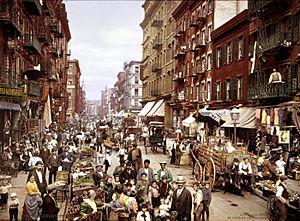
From 1890 to 1930, big cities like New York were very important. Skyscrapers and tourist spots were widely shown to the public. Suburbs existed, but they were mostly places where people lived and then traveled to the city for work. While other cities were important in their regions, New York City was the most important city in the entire nation. It led in communication, trade, finance, and culture. More than a quarter of the 300 largest companies in 1920 had their main offices in New York City.
In 1898, the modern City of New York was formed. This happened when Brooklyn (which was an independent city) joined with Manhattan and other nearby areas. Manhattan and the Bronx became two separate boroughs. Three other boroughs were created from parts of nearby counties to form the new city government, called "Greater New York." The Borough of Brooklyn included the independent City of Brooklyn, which had recently been connected to Manhattan by the Brooklyn Bridge. The Borough of Queens was made from western Queens County. The rest of Queens County became Nassau County in 1899. The Borough of Richmond included all of Richmond County. Local governments within these boroughs were removed, and the city or each borough took over county government duties. In 1914, New York State created Bronx County, making five counties that matched the five boroughs.
The Bronx had a steady boom from 1898 to 1929. Its population grew six times, from 200,000 in 1900 to 1.3 million in 1930. The Great Depression caused a rise in unemployment, especially among working-class people, and slowed growth. After a short boom during World War II, The Bronx declined from 1950 to 1985. It changed from mostly moderate-income to mostly lower-income, with high crime and poverty rates. However, The Bronx has been improving economically and developmentally since the late 1980s, and this continues today.
On June 15, 1904, over 1,000 people, mostly German immigrant women and children, died when the steamship General Slocum caught fire and sank. This was the city's worst disaster at sea. On March 25, 1911, the Triangle Shirtwaist Factory fire in Greenwich Village killed 146 garment workers. In response, the city greatly improved its fire department, building rules, and workplace safety laws.
Throughout the first half of the 20th century, New York City became a world center for industry, business, and communication. Events like the Hudson–Fulton Celebration of 1909 showed its growing importance. The Interborough Rapid Transit Company (the first New York City Subway company) started operating in 1904. Train stations like Grand Central Terminal and Pennsylvania Station were very busy.
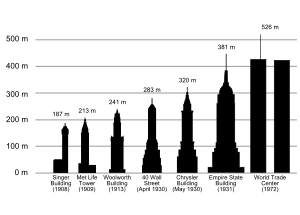
The city was a destination for people moving within the country, as well as immigrants. Until 1940, New York City was a major destination for African Americans during the Great Migration from the rural American South. The Harlem Renaissance was a time of great artistic and cultural growth in the 1920s, during the era of Prohibition. New York City's fast changes and rising crime and poverty rates slowed down after World War I disrupted trade. New laws limited immigration after the war, and the Great Depression reduced the need for new workers. This combination ended the power of the wealthy "Gilded Age" leaders. As the city's population became more stable, labor unions helped working-class people gain new protections and middle-class wealth. The city's government and buildings were greatly improved under Mayor Fiorello La Guardia and his parks commissioner, Robert Moses. Moses cleared many poor tenement areas, built new parks, remade streets, and changed zoning rules.
For a while, New York City was the most populated city in the world, taking over from London in 1925. During the tough years of the Great Depression, the reformer Fiorello La Guardia was elected mayor. Tammany Hall lost its political power after eighty years.
Even with the Great Depression, some of the world's tallest skyscrapers were built in the 1930s. These included Art-Deco masterpieces like the Chrysler, General Electric, and Empire State buildings, which are still part of the city's skyline today. Before and especially after World War II, large parts of the city were also changed by the building of bridges, parks, and parkways. These projects were led by Moses, who strongly believed in city planning focused on cars.
Post–World War II Era: 1946–1977
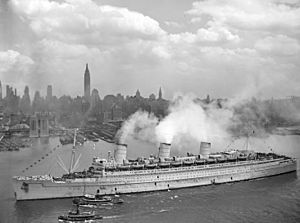
Soldiers returning from World War II and immigrants from Europe created a strong economy after the war. The G.I. Bill helped veterans get new housing, leading to the development of large suburban areas in eastern Queens and Nassau County. Photographer Todd Webb extensively photographed the city during these years.
New York came out of the war as the world's leading city, with Wall Street guiding the United States' rise to power. In 1951, the United Nations moved its headquarters from Flushing Meadows Park in Queens to the East Side of Manhattan. By the late 1960s, the ideas of city planner Robert Moses became less popular. Instead, the views of Jane Jacobs, who was against large-scale urban renewal, gained support. Citizens stopped a plan to build an expressway through lower Manhattan.
The city's economy began to shift from industry to services. Jobs in shipbuilding and clothing manufacturing sharply declined. Ports started using container ships, which meant fewer traditional jobs for longshoremen. Many large companies moved their main offices to the suburbs or other cities. At the same time, there was huge growth in service industries like finance, education, medicine, tourism, communication, and law. New York remained the largest city and metropolitan area in the United States. It continued to be the biggest center for finance, business, information, and culture.
Like many major U.S. cities, New York faced race riots, gang wars, and a drop in population in the late 1960s. Activists and minority groups like the Black Panther Party and Young Lords organized protests. They demanded better city services for poor areas. They also set up free health clinics and other programs to help people gain "Power to the People." By the 1970s, the city was seen as a crime-ridden place. In 1975, the city government avoided bankruptcy only with a federal loan and help from the Municipal Assistance Corporation. The city also had to accept more financial checks from a New York State agency. In 1977, the city was hit by two crises: the New York City blackout of 1977 and serial killings by the Son of Sam.
Recent History: 1978–Present
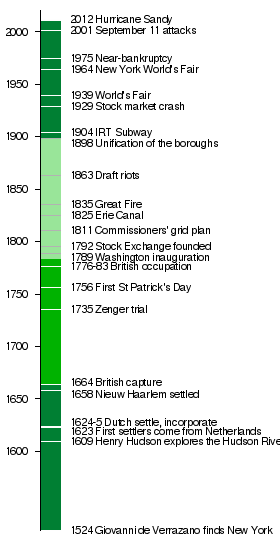 |
The 1980s saw Wall Street become strong again, and the city returned to its role as a global financial center. Unemployment and crime remained high, with crime reaching its worst levels around the end of the 1980s and early 1990s. City and state money helped restore neighborhoods like Bedford-Stuyvesant, Harlem, and The Bronx. The city then began to recover socially and economically. This was helped by new people moving in from Asia, Latin America, and other parts of the U.S. New crime-fighting methods by the NYPD also helped. In the late 1990s, the city benefited from the success of financial areas like Silicon Alley during the dot com boom. This was one reason for a decade of rising real estate values. New York also attracted more businesses and turned old industrial areas into art districts or nice places to live. Examples include the Meatpacking District and Chelsea in Manhattan, and Williamsburg in Brooklyn.
New York's population reached its highest point ever in the 2000 census. Since 2000, the city has continued to grow, especially Manhattan. On September 11, 2001, New York City was the site of the September 11 attacks. A terrorist attack on the World Trade Center killed 2,606 people in and around the towers. This was a very difficult event for the city, but it did not stop New York's quick regrowth. On November 3, 2014, One World Trade Center opened at the site of the attack. Hurricane Sandy brought a powerful storm surge to New York City on October 29, 2012. It flooded many streets, tunnels, and subway lines in Lower Manhattan. It also flooded low-lying areas of Brooklyn, Queens, and Staten Island. Many parts of the city and its suburbs lost electricity.
Images for kids
-
George Washington enters New York in triumph following the British evacuation of America.
See also
 In Spanish: Historia de Nueva York para niños
In Spanish: Historia de Nueva York para niños


